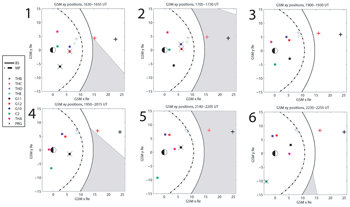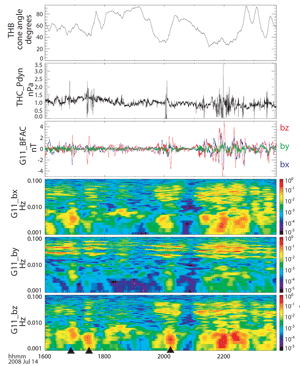
2013 THEMIS SCIENCE NUGGETS
The role of transient ion foreshock phenomena in driving Pc5 ULF wave activity
by Michael Hartinger, U. Michigan AOSS
Introduction
A low correlation between the Interplanetary Magnetic Field (IMF) cone angle and Pc5 (2-7 mHz) wave activity found in previous studies suggests that the ion foreshock is not an important energy source for Pc5 Ultra Low Frequency (ULF) waves. However, there is an alternative explanation for this low correlation: Transient Ion Foreshock Phenomena (TIFP). TIFP is an umbrella term that refers to many different phenomena, such as hot flow anomalies and foreshock bubbles, that can generate large dynamic pressure fluctuations in the ion foreshock. In a case study, we show that TIFP drive large amplitude Pc5 waves with low correspondence to the IMF cone angle.
Results
We used data from the THEMIS, GOES, and Cluster spacecraft over an 8 hour high speed solar wind interval on 14 July 2008. Observations from the pristine solar wind and ion foreshock showed that several TIFP occurred during this period; they were associated with large deflections of the bulk flow and large fluctuations in the dynamic pressure in the ion foreshock – in contrast, the dynamic pressure and bulk flow of the solar wind remained steady. Observations at different magnetic local times in the magnetosphere showed large amplitude Pc5 wave activity associated with these TIFP. Figure 1 shows that the location of peak wave amplitude for different time intervals coincided with the location of the ion foreshock (the morphology of the ion foreshock changed as the IMF changed).
| Figure 1. These plots show the connection between the ion foreshock location and the location where peak ULF wave amplitude is observed in the magnetosphere near geosynchronous orbit. Numbered panels correspond to different time intervals. Each panel shows the probe positions and ion foreshock location in the GSM xy plane during the interval; the solid black line indicates the bow shock and the dot-dashed line indicates the magnetopause. The x’s indicate the location of the peak ULF wave response measured at geosynchronous orbit (referred to as PRG in the legend)—panel three does not have an x because no significant ULF wave activity occurred during that interval (the ion foreshock was not upstream of the dayside magnetosphere). |
Figure 2 shows observations from one of the GOES probes during the 8 hour interval. Both Pc5 and Pc3-4 waves (frequency > 7 mHz) are seen; The Pc3-4 waves have different polarization than the Pc5 waves and can occur at different times. Focusing on fluctuations in the z component (bottom panel), Pc3-4 wave activity appears more closely related to reductions in IMF cone angle whereas Pc5 wave activity is related to dynamic pressure fluctuations in the ion foreshock and is not closely tied to the IMF cone angle.
| Figure 2. This plot shows an overview of ULF wave activity observed at geosynchronous orbit. Two classes of waves are observed, Pc3–4 perturbations (frequency > 7 mHz) with harmonic structuring and highest amplitudes in the east-west component and Pc5 (frequency < 7 mHz) perturbations strongest in the compressional and radial components. From top to bottom: (1) IMF cone angle observed at THB, (2) dynamic pressure observed at THC, (3) magnetic field perturbations observed at G11 in field-aligned coordinates, dynamic power spectra for the (4) radial, (5) east-west, and (6) field-aligned magnetic field perturbations. |
Conclusion
The ion foreshock may be a more important driver of Pc5 waves than previously thought. The IMF cone angle may not be the best indicator of times when TIFP can drive Pc5 waves; TIFP themselves are often associated with IMF discontinuities and potentially rapid changes in the cone angle, making it difficult to find correlations between Pc5 waves driven by TIFP and IMF cone angle. Surprisingly, the amplitude of these Pc5 waves is as large (~5-10 nT) as wave amplitudes occurring during geomagnetic storms, yet they are triggered (via TIFP) by discontinuities in the IMF that are not typically considered important for solar wind-magnetosphere coupling.
Reference
Hartinger, M. D., D. L. Turner, F. Plaschke, V. Angelopoulos, and H. Singer (2013), The role of transient ion foreshock phenomena in driving Pc5 ULF wave activity, J. Geophys. Res. Space Physics, 118, 299–312, doi:10.1029/2012JA018349.Biographical Note
Michael Hartinger is a postdoctoral research fellow in the Atmospheric, Oceanic and Space Sciences Department at University of Michigan. http://aoss.engin.umich.edu/people/mdhartin
 Please send comments/suggestions to
Emmanuel Masongsong / emasongsong @ igpp.ucla.edu
Please send comments/suggestions to
Emmanuel Masongsong / emasongsong @ igpp.ucla.edu


